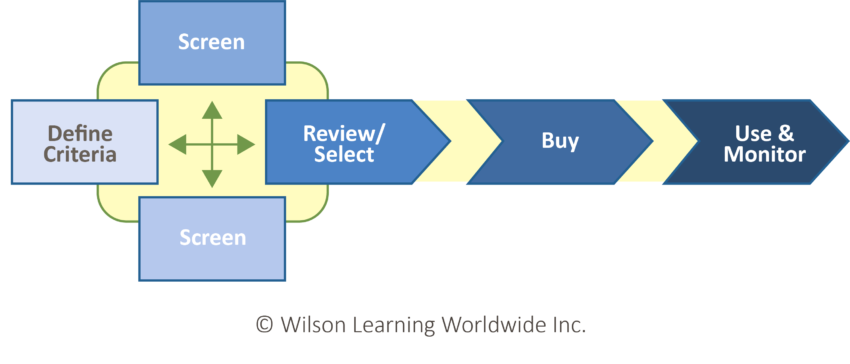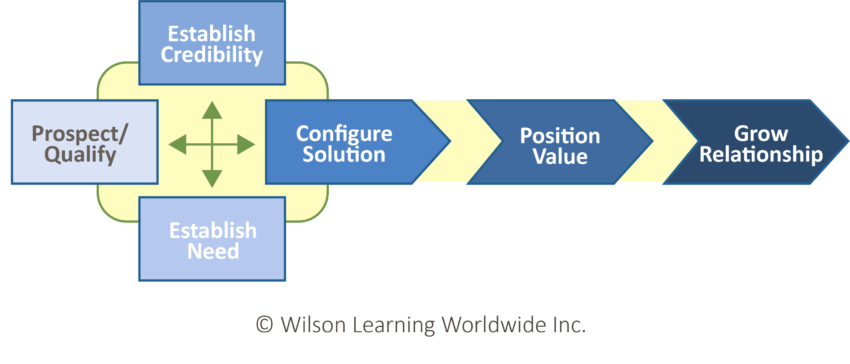Who’s in charge of the sales process? Today, it’s the customer. But six key steps in the emerging sales process help salespeople get a strong foothold in today’s buy-sell relationship and build better long-term relationships.
If you think your salespeople can control the way buyers buy—think again. The old adage that “people love to buy, but hate to be sold” has changed to “people know how to buy, and won’t be sold to.” But, that doesn’t mean it’s time to fire your salesforce. With a little insight into today’s buying process, salespeople can understand how customers buy and dramatically increase their sales results.
Knowledgeable Customers
New technology is changing the buying process. American Marketing Association reports that the vast majority of customers find sellers before sellers find the customer. Through websites and consulting services, customers have multiple resources to identify, screen, and select vendors without contacting them and often reject sellers before the sellers even know they have been screened out. This is a significant change in how buyers buy and requires an equally significant change in how sellers sell.
Changes in the buying process are creating fundamental changes in the sales process. In the past, the sales process was the driver of the interaction between the customer and the seller. Salespeople prospected for new customers, led the identification of needs and requirements, proposed solutions, and closed a sale.
Today, it is the buyer who is in charge of the speed and direction of the sale.

As illustrated at right, customers do not follow a linear process. They gather information about available solutions and options and screen potential providers, and through that process continue to gather more information. They select only those providers they want to consider, and use the knowledge gathered from those providers to further refine their requirements. The use of decision teams rather than a single decision maker is the new norm, especially with strategically important buying decisions. There are multiple influencers and, most importantly, multiple people with “veto power.” But the buying process does not end there. Procurement departments frequently manage the actual purchase, gathering additional information and comparing the chosen offering to others based on performance and price to ensure maximum value. And finally, buyers have found that they can ask for, and get, additional support and value-added services throughout the lifetime of the product.

How does a salesforce differentiate in an environment like this? Successful ones have learned to adapt their sales process to the buyer’s buying process, aligning with how the customer wants to buy.
Here Are the Six Key Steps of Today’s Sales Process:
- Prospect: Traditionally, prospecting focused on identifying and qualifying the individual buyer within the account: Who’s the decision maker? Do they have the financial resources? Prospecting today focuses more attention on first qualifying the account: Will they buy and when will they buy? What is their buying cycle? How do they make decisions and how do they shop? Qualifying the contact has shifted to qualifying the buying decision team—their role in the decision process, predispositions, and personal motives.
- Establish Credibility: Successful salespeople position themselves and their organization as a trusted source of information and a trustworthy advisor long before the customer is ready to buy or has even identified the problem. Since organizations are pre-screening potential providers, a salesperson cannot wait until there is an identified need to approach a prospect; they need to get on the “must contact” list to have even a hope of making a sale.
- Establish Need: Needs-based discovery is still critical, but it’s not enough. Customers come to the needs discovery phase with already-defined criteria, and successful salespeople know how to use their industry and customer expertise to tie these needs to the organization’s strategy and critical success factors. Instead of focusing on requirements and criteria, sales can help with calculating the ROI of making the purchase.
- Configure Solution: Gone are the days when simple product offerings would differentiate you from the competition (“Do you want that in red or blue?”). Today, providers who survive the review and select step understand how to configure the whole product, which includes product elements and features, as well as non-product elements like delivery, financial arrangements, service-level agreements, systems integration, etc.
- Position Business Value: The “Buy” step of the buying process often involves executive review and buy-in. A Wilson Learning study, as well as research by the Brandon Hall Group, shows that when buying executives were asked, as many as 90% indicated the salespeople they meet do not know how to show the business value of their products or services. Highly effective salespeople know that executives are not interested in features and benefits, but need to know how their purchase will affect the bottom line or improve their ability to implement strategy.
- Grow Relationship: The cost of acquiring a new customer has always been higher than reselling to an existing customer, and research at Aberdeen shows this cost difference has increased. In addition, a survey of sales executives indicates that salespeople are not very good at reselling to existing customers, with over 60% indicating that salespeople leave money on the table because of poor cross-selling and up-selling. Successful salespeople help customers use and monitor their purchases; they act as risk managers for their clients, supporting implementation and recognizing that the absence of expressed dissatisfaction is not the same thing as having a satisfied and engaged customer.
Working together with buyers throughout the buying process can help salespeople develop trust and build stronger, longer-lasting relationships. Successful salespeople become experts in their customers’ businesses, function as problem-solvers, and think more about customers’ needs and challenges throughout the buying process and less about their own sales process. This creates a sales organization truly focused on the customer.

